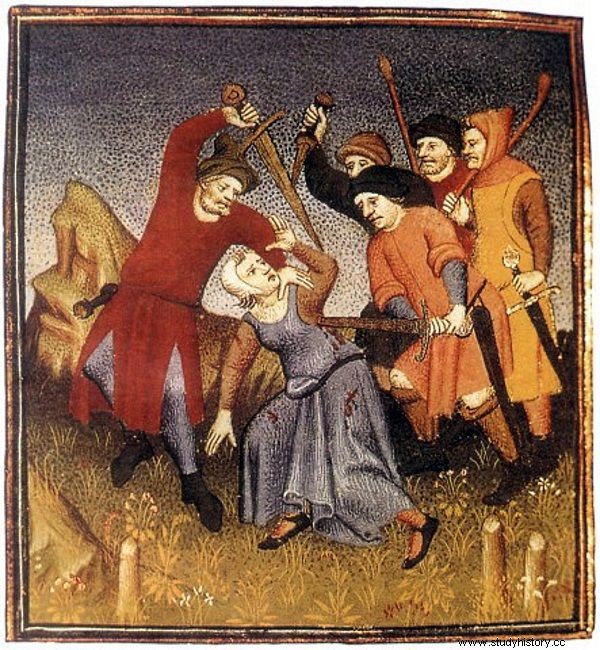We all know the story of the hooded archer Robin Hood and his merry company dealing with the evil Sheriff of Nottingham. The real story of outlaws, however, has little to do with plundering the rich and handing out to the poor. Instead, it's full of theft, bloodshed and rape.
The colleagues of the notorious sheriff's profession Robin fought so fiercely had a hard time to crack. Medieval England was the seat of all pathologies with which they had to fight without sparing their resources. At the same time, it was on their heads to carry out about 120 royal orders a month, to gather soldiers for war and catch criminals. We can therefore assume that the officials wanted to deal with bandits and other outlaws quickly and efficiently. They might have wanted to, but… little else. The problem was that the sheriff was not allowed to pass sentences on murderers and all kinds of bandits.
Meanwhile, there was no shortage of criminals, and crime was of an eminently family character. As Ian Mortimer emphasizes in the book In the city, at court, in a monastery. How to survive in medieval England? , about a third of organized gangs in England gathered entire families - husbands and wives, brothers, sometimes even sisters. In a word, mafia clans.
Among other things, the author gives an example of the outlawed Warnaut family of Salle in Norfolk, which consisted of:
[…] three sisters, a brother, and another relative, John Warnaut. In 1321, two sisters and a brother are accused of taking stolen goods. They avoid punishment, as did the third sister later. John, on the other hand, is found guilty of theft […] and hanged.
The rest of the family constantly come into conflict with the law, ending up in prison, then leaving it. They also do not stop committing crimes, namely stealing by power. However, they are still mere small hurdles compared to the real crime sharks. One of them was the Folville gang, headed by its leader Eustace. Its members have dealt bloodily with the enemy of the family.

The poor were not attacked. because they were too poor for that. The ideal victims of bulls are lay and church dignitaries.
Murdered by them in 1326, Roger Bellers held a high official position, he was considered a real personality. In addition, he was a protégé of the royal favorite, which did not bode well for people who wanted his life. After the Folvills committed their crimes, they fled abroad.
Although due to political turmoil, the trial against them is canceled and they are acquitted, they still follow the path of wrongdoing, raping, robbing and murdering. If they were common thugs, the royal judiciary could deal with them swiftly, but the Folvills are landed heirs, and that makes them almost untouchable.
The crimes of "fur collars"
Barbara Hanawalt quotes in Of Good and Ill Repute the definition of "white collar criminals" by the American sociologist Edwin H. Sutherland. They are people of high social status who use their position to break the law. When translating things into the realities of medieval England, collars should be replaced with fur ones, but the rest is correct. The worst gangsters were the nobles who, having the servants and their subordinate knights at their disposal, formed their own bands and, using their position, often avoided any responsibility for their misdeeds.
Even the close friends of the rulers followed such a path. Sir Roger de Leiburn, friend and supporter of Edward I the Long-legged (1272-1307), was one such person. When the relationship between him and the monarch grew cold, he gathered a gang around him and began living a life of crime. So did Sir William Aune. This nobleman went down the road of crime when he was prevented from inheriting the property that he believed was his own.
In some Robin Hood stories the name of the current ruler appears:Edward. According to some researchers, it is about the aforementioned Edward I, and it was in his time that the famous hooded outlaw was supposed to work. Its existence is not 100% confirmed in sources, but the activities of another "happy company", which in addition prowled in Sherwood Forest, are well documented. As Ron Catterall states in Robin Hood Memories of the Coterel Gang it would be hard to find someone in the Cotterell family who hasn't heard of this folk hero.

Birch trees in the famous Sherwood forest. In this beautiful scenery, both legendary and completely real bandits were prowling. (Photo released under the CCA BY-SA3.0 license)
Members of the early fourteenth century gang would probably be extremely proud if they knew that some of their crimes and deeds were attributed to Robin Hood. Their activities, however, had nothing to do with taking away the rich and giving away to the poor. Instead, they kidnapped people for ransom and stole on a massive scale. As reported by Ian Mortimer in the book In the city, outside, in the monastery. How to survive in medieval England? their:
[...] brazen banditry, of course, echoes and results in the appointment of a strict commission in the same year, headed by the three most important judges in the kingdom [...]. Despite this show of power from the government, the commission has failed to bring the worst criminals to justice […].
Only a quarter of the 200 of their supporters for whom an arrest warrant has been issued are brought to trial. In addition, the vast majority of them are acquitted, because the king's officials are simply afraid to sentence them. Fortunately for law-abiding citizens, and not for bandits, the story of the Folvills ends. In 1340 the keepers of order manage to get them. Though gangsters take refuge in the church and neck dozens of arrows from its bow windows, one by one they are dragged outside and beheaded.
